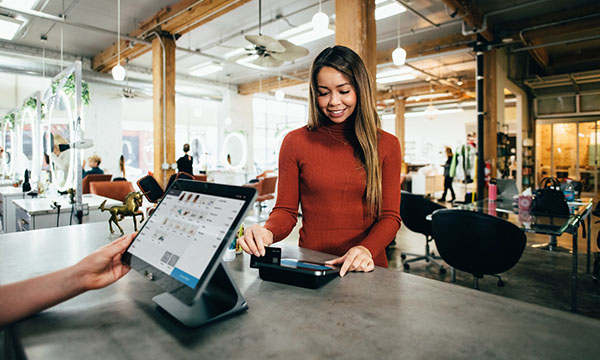
The Future of Credit Cards & How People Spend
Think about it: When was the last time you bought something with cash?
Can’t remember? You may be one of the millions of credit cardholders in the world who are now accustomed to digital currency. Credit (and debit) card usage has increased in popularity in recent months - in large part to the on-going COVID-19 pandemic. As more people buy online, advancing technology and the need for credit are changing the landscape of how we spend.
And it begs the question: Are we heading towards a card-fueled, cash-free future? To find out, we need to start with where credit cards are going.
Here are three major technological card advances that are reshaping the way we spend money:
Redesigned card security
An important physical aspect of credit cards that is currently in the process of elimination is the magnetic stripe or 'magstripe'. The magstripe stores cardholders’ information, like account details, and spending limit. As credit card fraud increased, technology advanced for a more protective measure of retrieving cardholder information.
 Thus, the EMV chip was implemented - creating a unique transaction code for each purchase with each ‘dip’ a person makes. ‘Dipping’ is the term coined to replace ‘swiping’ a credit card. This code protects people against fraudulent activity and from hackers stealing information from swiped cards.
Thus, the EMV chip was implemented - creating a unique transaction code for each purchase with each ‘dip’ a person makes. ‘Dipping’ is the term coined to replace ‘swiping’ a credit card. This code protects people against fraudulent activity and from hackers stealing information from swiped cards.

EMV chips provide cardholders with more confidence when using cards for everyday purchases. It also provides banks more security to prevent losses - and the potential to approve more lines of credit.
Accessibility with digital wallets
The projected increase of credit card users worldwide is expected to climb to 1.2 billion by 2022, while the number of smartphone users in the world has recently exceeded 3.5 billion. Combined, these stats have made digital wallets and credit cards easily accessible.
Does that mean that the future of cards looks… cardless?
Perhaps. ‘Digital wallets’ refer to online services, electronic devices, and software programs that make electronic transactions for goods and services easy. Here’s how they work: Once an individual links their bank or credit card to their e-wallet account, the funds can then be transferred to another individual or retailer’s online e-wallet account once the goods and services have been given. Popular e-wallet services include Paypal, Venmo, and Cash App.
E-wallets may come in two versions: cold and hot. Hot wallets require an internet connection, while cold wallets are able to function without being connected. Hot wallets are good for everyday purchases, while cold wallets are best for storing money - similar to storing Bitcoins offline. E-wallets provide individuals with different options that meet their specific needs while removing the hassle of physical currency. Ultimately, making spending quicker, safer, and more convenient.
This cardless ‘card’ option virtually eliminates the need for carrying dealing with cash while saving the individual time from going through the bank's drive-thru or stopping at an ATM and incurring a hefty processing fee.
Artificial intelligence predicts fraud
As discussed in our previous blog, “Evolution of a business tool: How to use credit cards to manage company spend,” the accessibility of user data created a marked increase in the number of credit cards being issued around the turn of the millennium. Now, banks are combining data with artificial intelligence to predict spending habits and fraud.
For both personal and business, AI analyses customer and merchant data to detect the likeliness of fraudulent transactions. The type of purchase, time of day of the purchase, and geographic location are all major factors that AI takes into consideration in determining if an account is at-risk.
If AI determines that the factors seem out of character for a person’s spending habits, it alerts the bank - which in turn alerts the cardholder. This protects banks, buyers, and businesses.
Over time, the AI will learn the purchasing habits of the cardholder through algorithms of how and what the credit card is used to purchase. Eventually, the AI will instantly be able to understand and determine if a purchase is legitimate. Simultaneously, the AI has the potential to discover previously overlooked fraudulent charges and start flagging transactions more regularly.
A cashless future - COVID + Credit cards + The death of cash?
Most of these advancements in credit card technology have been underway for the past decade - perhaps waiting for society to fully adopt them. Enter: COVID-19.
Due to the pandemic, consumers and businesses have begun to fully embrace card technology at an accelerated rate. Out of necessity, businesses and individuals quickly adapted to an entirely contactless way of living. Online shopping, restaurant take-away,, and other touchless transactions of goods and services became the new standard nearly overnight.
Moreover, online shopping increased by over 76% in the month of June due to store closures - resulting in more credit card usage than ever. Curbside pickup for grocery stores has seen a huge surge in popularity. Customers shop and pay for their items online and then pick them up at a designated time - for a completely digital transaction.
In addition, the United States is currently experiencing a coin shortage due to COVID, further fueling a switch to card purchasing. Businesses and restaurants that have reopened, are now encouraging (or requiring) customers to use credit cards over cash due, simply, to a lack of change.
While the changes in the way that society makes purchases were not caused directly by COVID-19, the pandemic has accelerated the adaptation of new credit card and purchasing technology.
The need for physical currency has been steadily declining since the turn of the 21st century as credit and debit cards became the standard. ATM cash withdrawals have plummeted to just 25% this year in the US - a far cry from the norm. And while paper cash is still a trusted and legal tender, society has slowly shifted - and hastily thrust - away from it. We now live in a world of digital currencies - both in our wallets and on our mobile phones.
All of this, combined with the fact that over 90% of the world’s wealth on computers and hard drives, could mean that a cashless society may be a reality in the not-so-distant future. A society where cards aren’t king, they’re everything - even if it’s cardless.

